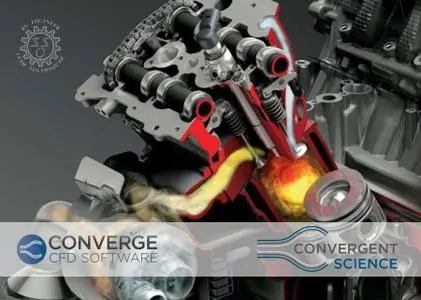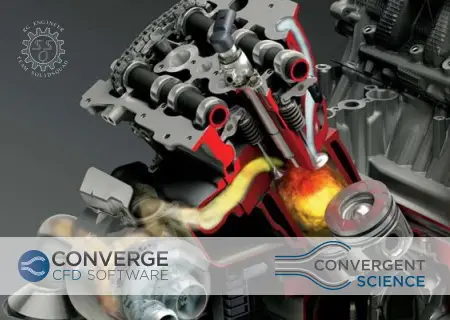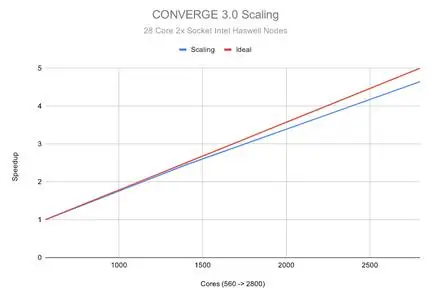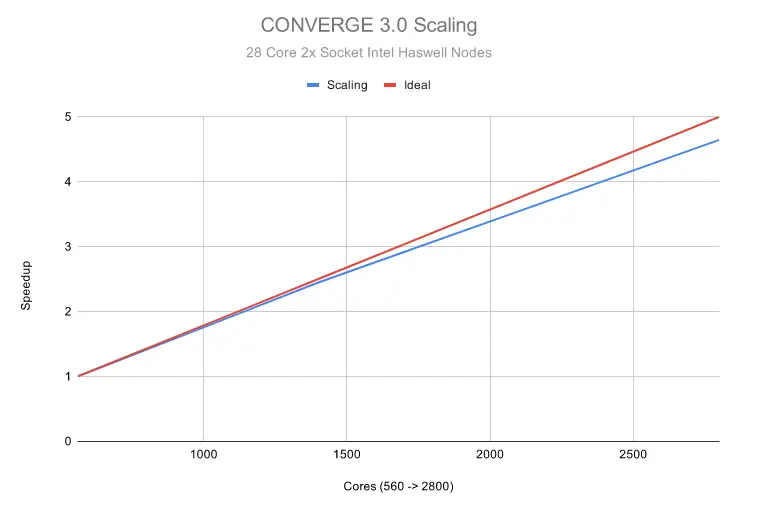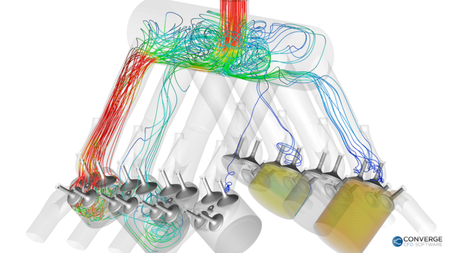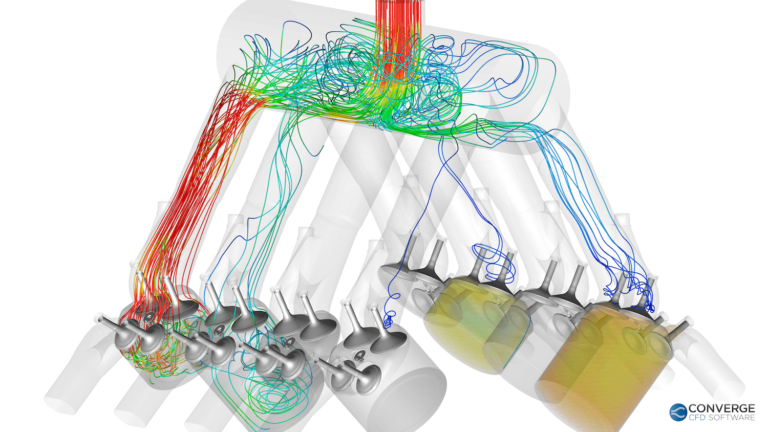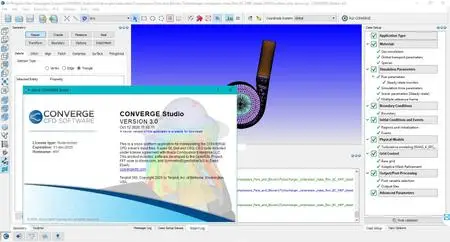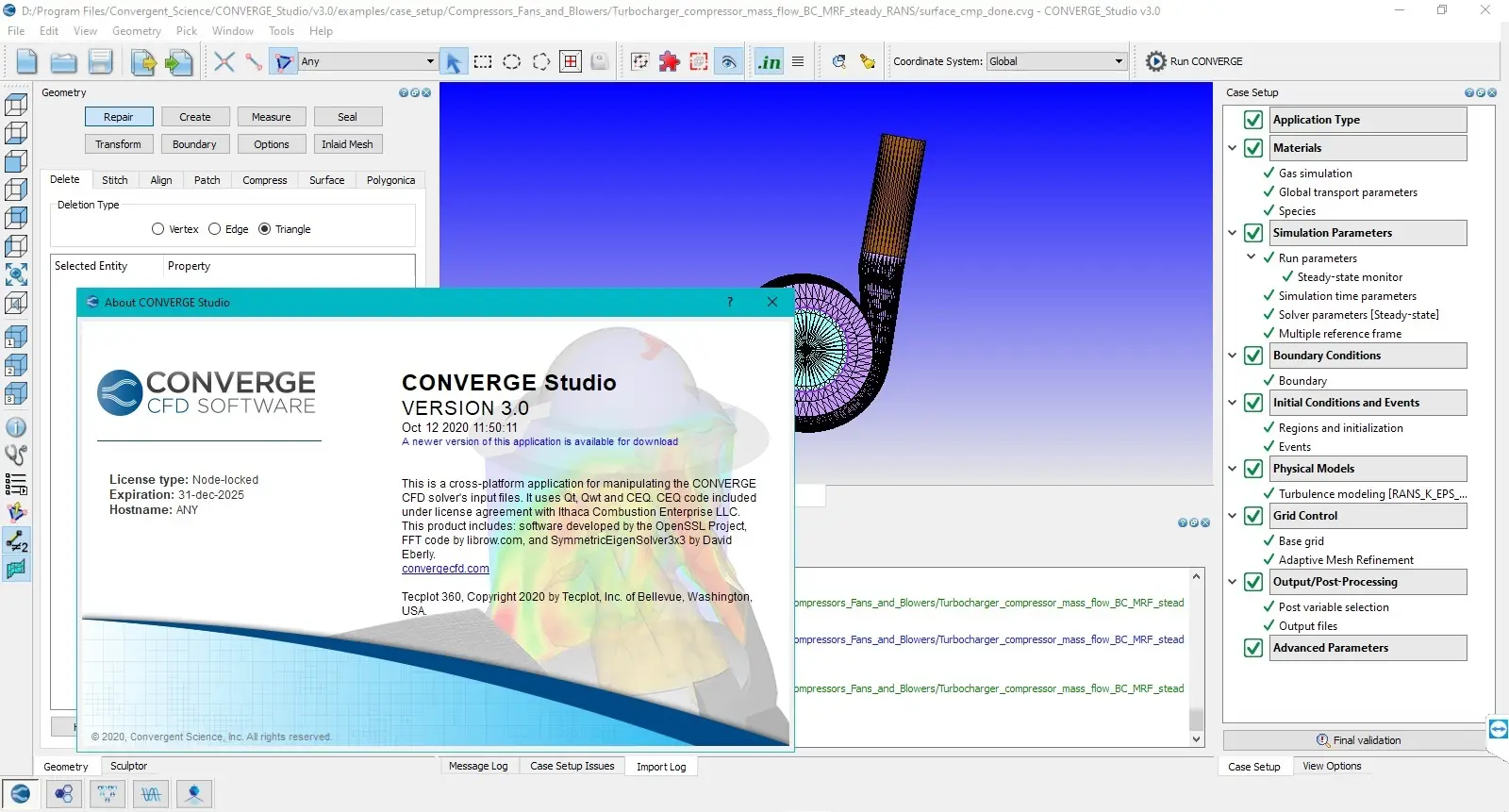CONVERGE Studio 3.0 with Solvers | 2.6 Gb
Convergent Science has released the highly anticipated new version of their computational fluid dynamics (CFD) software, CONVERGE 3.0. CONVERGE 3.0 builds on previous versions with new features, enhancements, and expanded capabilities. One of the most notable enhancements in CONVERGE 3.0 is a dramatic improvement in scaling—users will see significant speedup when running the software on large numbers of processors.
“In CONVERGE 3.0, we switched from partitioning the domain on blocks coarser than the solution grid to partitioning the solution grid directly,” says Keith Richards, co-owner of Convergent Science and one of the principal developers of CONVERGE. “This allows us to get a good load balance for any solution mesh, including those with very high levels of embedding, and means CONVERGE scales well even on thousands of cores.”
The way CONVERGE stores information during simulation runtime has also been modified in version 3.0, resulting in a greatly reduced memory footprint. Additionally, CONVERGE’s post-processor, Tecplot for CONVERGE, is more seamlessly integrated into the software, creating a smoother workflow for users.
CONVERGE 3.0 offers more flexibility in meshing than previous versions. With autonomous meshing, CONVERGE automatically generates an optimized Cartesian mesh at runtime. In 3.0, users can optionally incorporate an inlaid mesh in a region of the grid to obtain accurate results with fewer cells. Inlaid meshes can be aligned with the flow direction to reduce numerical viscosity, or users can refine the mesh in only one or two directions instead of all three. This allows users to accurately resolve boundary layers, for example, at a reduced computational cost by increasing mesh resolution only normal to the wall.
Among the new features in CONVERGE are two new combustion models. The thickened flame model for use in conjunction with LES (TFM-LES) is useful for simulations with large differences in length scales, like resolving the flame front in a boiler. The second new model, SAGE PDF, accounts for turbulence-chemistry interactions in flames modeled with RANS.
CONVERGE’s chemistry capabilities have also been enhanced in version 3.0. The SAGE detailed chemistry solver has seen significant speedup, especially for large reaction mechanisms, making CONVERGE one of the fastest chemistry solvers on the market. In addition, CONVERGE 3.0 includes numerous new chemistry tools, including new 0D chemical reactors, a new 1D flamespeed solver, and enhanced tools for manipulating chemical mechanisms.
CONVERGE is a revolutionary computational fluid dynamics (CFD) program thateliminates the grid generation bottleneck from the simulation process. CONVERGE wasdeveloped by engine simulation experts and is straightforward to use for both engine andnon-engine simulations. Unlike many CFD programs, CONVERGE automaticallygenerates a perfectly orthogonal, structured grid at runtimebased on simple, user-definedgrid control parameters. This grid generation method completely eliminates the need tomanually generate a grid. In addition, CONVERGE offers many other features to expeditethe setup process and to ensure that your simulations are as computationally efficient aspossible.
CONVERGE CFD software comprised of the CONVERGE solver, the CONVERGE Studio graphical user interface (GUI), and CONVERGE chemistry tools.
CONVERGE Solver
The CONVERGE solver is designed for solving reacting flows in systems with complex geometries and moving parts. One of the key features of CONVERGE is ‘autonomous meshing’, in which CONVERGE automatically creates and refines the computational mesh, thereby taking the meshing process out of the users’ hands. CONVERGE’s autonomous meshing features include automatic mesh generation and Adaptive Mesh Refinement.
CONVERGE Studio
The CONVERGE Studio GUI includes both pre- and post-processing tools for the CONVERGE solver. Before running a CFD simulation in CONVERGE, the CONVERGE Studio pre-processing tools can be used to prepare the surface geometry, configure input files, and set up the reaction mechanism. After running a CONVERGE simulation, the line plotting module and the 3D visualization module in CONVERGE Studio can be used to visualize and interpret the simulation results.
CONVERGE Chemistry Tools
CONVERGE includes a number of chemistry tools for the SAGE detailed chemistry solver. These tools include the 0D solver, 1D solver, mechanism reduction, mechanism merge, mechanism tuning, and surrogate blender. The 0D, or autoignition, solver calculates ignition delay for a given set of fuel parameters, e.g., temperature, pressure, equivalence ratio. The 1D solver calculates laminar flame speeds.To reduce computational time, the mechanism reduction tool eliminates species and reactions that have the least effect on the simulation results. The mechanism merge tool combines two reaction mechanisms into one,and the mechanism tuning tool optimizes reaction mechanisms to meet specified performance targets. In CONVERGE Studio, the surrogate blender tool approximates real fuels through multi-component surrogates whose properties match those of the target fuel.
Although earlier versions of CONVERGE show good runtime improvements with increasing core counts, speedup is limited for cases with significant local embeddings. CONVERGE 3.0 has been specifically developed to run efficiently on modern hardware configurations that have a high number of cores per node.
With CONVERGE 3.0, we have observed an increase in speedup in simulations with as few as approximately 1,500 cells per core. With its improved scaling efficiency, this new version empowers you to obtain simulation results quickly, even for massive cases, so you can reduce the time it takes to bring your product to market.
CONVERGE 3.0 features a multitude of new features and enhancements. In this inside look at 3.0, you’ll hear CONVERGE developers discuss significant improvements in scaling, a host of new 0D and 1D chemistry tools, substantial memory savings, inlaid grids, and more.
Founded in 1997 by graduate students at the University of Wisconsin-Madison, Convergent Science was a CFD consulting company in its early years. In 2008, the first CONVERGE licenses were sold and the company transitioned to a CFD software company. Convergent Science remains headquartered in Madison, Wisconsin, with additional offices in the United States, Europe, and India and distributors around the globe. Our flagship product, CONVERGE CFD, is a revolutionary CFD software that eliminates the grid generation bottleneck from the simulation process.
Product: CONVERGE Studio
Version: 3.0 (2020.10.12) with Solvers 3.0.17
Supported Architectures: x64
Website Home Page : https://convergecfd.com/
Language: english
System Requirements: PC *
Size: 2.6 Gb
Operating systems compatible with CONVERGE Studio.
- Windows Server 2003+
- Windows 7
- Windows 8
- Windows 10
Hardware and Software
For the CONVERGE solver, the amount of recommended RAM depends on the size of the domain; the level of grid refinement; the number of species, passives, and reactions in the mechanism; and other simulation-specific criteria. A small, simple simulation (e.g., an engine sector case) can be efficiently executed in serial on a single machine with less than 4 GB of RAM. Larger simulations (e.g., a port-fuel injected, full-cylinder simulation using the SAGE detailed chemistry solver) may require several multi-core machines to achieve a solution in a reasonable time.
CONVERGE supports any hardware architecture that uses the x86-64 instruction set. It is designed for consumer-class hardware and does not use enterprise-class additions to that instruction set. CONVERGE performs computations on conventional CPUs and does not use general-purpose GPU resources.
- Windows Server 2003+
- Windows 7
- Windows 8
- Windows 10
Hardware and Software
For the CONVERGE solver, the amount of recommended RAM depends on the size of the domain; the level of grid refinement; the number of species, passives, and reactions in the mechanism; and other simulation-specific criteria. A small, simple simulation (e.g., an engine sector case) can be efficiently executed in serial on a single machine with less than 4 GB of RAM. Larger simulations (e.g., a port-fuel injected, full-cylinder simulation using the SAGE detailed chemistry solver) may require several multi-core machines to achieve a solution in a reasonable time.
CONVERGE supports any hardware architecture that uses the x86-64 instruction set. It is designed for consumer-class hardware and does not use enterprise-class additions to that instruction set. CONVERGE performs computations on conventional CPUs and does not use general-purpose GPU resources.
Please visit my blog
Added by 3% of the overall size of the archive of information for the restoration
No mirrors please
Added by 3% of the overall size of the archive of information for the restoration
No mirrors please


